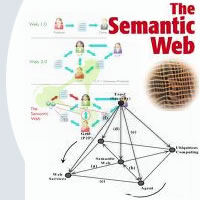Since Web 2.0 Innovations is all about discovering and showcasing the innovation on web, we think the Semantic Web is playing a significant role of the next web transformation. Therefore in a series of publications we will try to discover, highlight and feature the next generation of web-based semantic applications, engines, platforms, mash-ups, machines, products, services, mixtures, parsers, and approaches and far beyond.
 We are not going to try to explain in details what Semantic Web is after all. There has been plenty of information on web as to what does really that term mean. First off it is the Tim Berners-Lee W3C led initiative that touts technologies like RDF, OWL and other standards for metadata. Basically it promises to change how the web works in first place, to meaningfully connect the different datasets around web in a readable and usable format for both humans and robots.
We are not going to try to explain in details what Semantic Web is after all. There has been plenty of information on web as to what does really that term mean. First off it is the Tim Berners-Lee W3C led initiative that touts technologies like RDF, OWL and other standards for metadata. Basically it promises to change how the web works in first place, to meaningfully connect the different datasets around web in a readable and usable format for both humans and robots.
The Semantic Web is a web of data. There is lots of data we all use every day, and it’s not part of the web. One can see his/her bank statements or travel arrangements on the web, and the photographs and one can see his/her appointments in a calendar. But can one see his/her photos in a calendar to see what one was doing when she or him took them? Can one see the bank statement lines in a calendar?
Why not? Because we don’t have a web of data. Because data is controlled by applications, and each application keeps it to itself.
The Semantic Web is about two things. It is about common formats for integration and combination of data drawn from diverse sources, where on the original Web mainly concentrated on the interchange of documents. It is also about language for recording how the data relates to real world objects. That allows a person, or a machine, to start off in one database, and then move through an unending set of databases which are connected not by wires but by being about the same thing.
Some of the very basics Semantic components include:
— XML provides an elemental syntax for content structure within documents, yet associates no semantics with the meaning of the content contained within.
— XML Schema is a language for providing and restricting the structure and content of elements contained within XML documents.
— RDF is a simple language for expressing data models, which refer to objects (“resources”) and their relationships. An RDF-based model can be represented in XML syntax.
— RDF Schema is a vocabulary for describing properties and classes of RDF-based resources, with semantics for generalized-hierarchies of such properties and classes.
— OWL adds more vocabulary for describing properties and classes: among others, relations between classes (e.g. disjoint ness), cardinality (e.g. “exactly one”), equality, richer typing of properties and characteristics of properties (e.g. symmetry), and enumerated classes.
— SPARQL is a protocol and query language for semantic web data sources.
Here are some more links to plenty of resources that can get you to the basics and fundaments of the Semantic Web.
http://en.wikipedia.org/wiki/Semantic_Web
http://www.w3schools.com/semweb/default.asp
http://infomesh.net/2001/swintro/
http://www.w3.org/2000/10/swap/Primer (Getting Into RDF & Semantic Web Using N3)
http://www.w3.org/DesignIssues/Semantic (Semantic Web Roadmap)
http://purl.org/swag/whatIsSW (What Is The Semantic Web?)
http://uwimp.com/eo.htm (Semantic Web Primer)
http://logicerror.com/semanticWeb-long (Semantic Web Introduction – Long)
http://www.scientificamerican.com/2001/0501issue/0501berners-lee.html (SciAm: The Semantic Web)
http://www.xml.com/pub/a/2001/03/07/buildingsw.html (Building The Semantic Web)
http://infomesh.net/2001/06/swform/ (The Semantic Web, Taking Form)
http://www.w3.org/2001/sw/Activity (SW Activity Statement)
http://www.w3.org/2000/01/sw/ (SWAD)
If by any chance you are working for or being a part of, or just know about, a company or a team deploying Semantic Web in one way or another drop us a short note at info [at] web2innovations.com and we would love to feature your work here.
